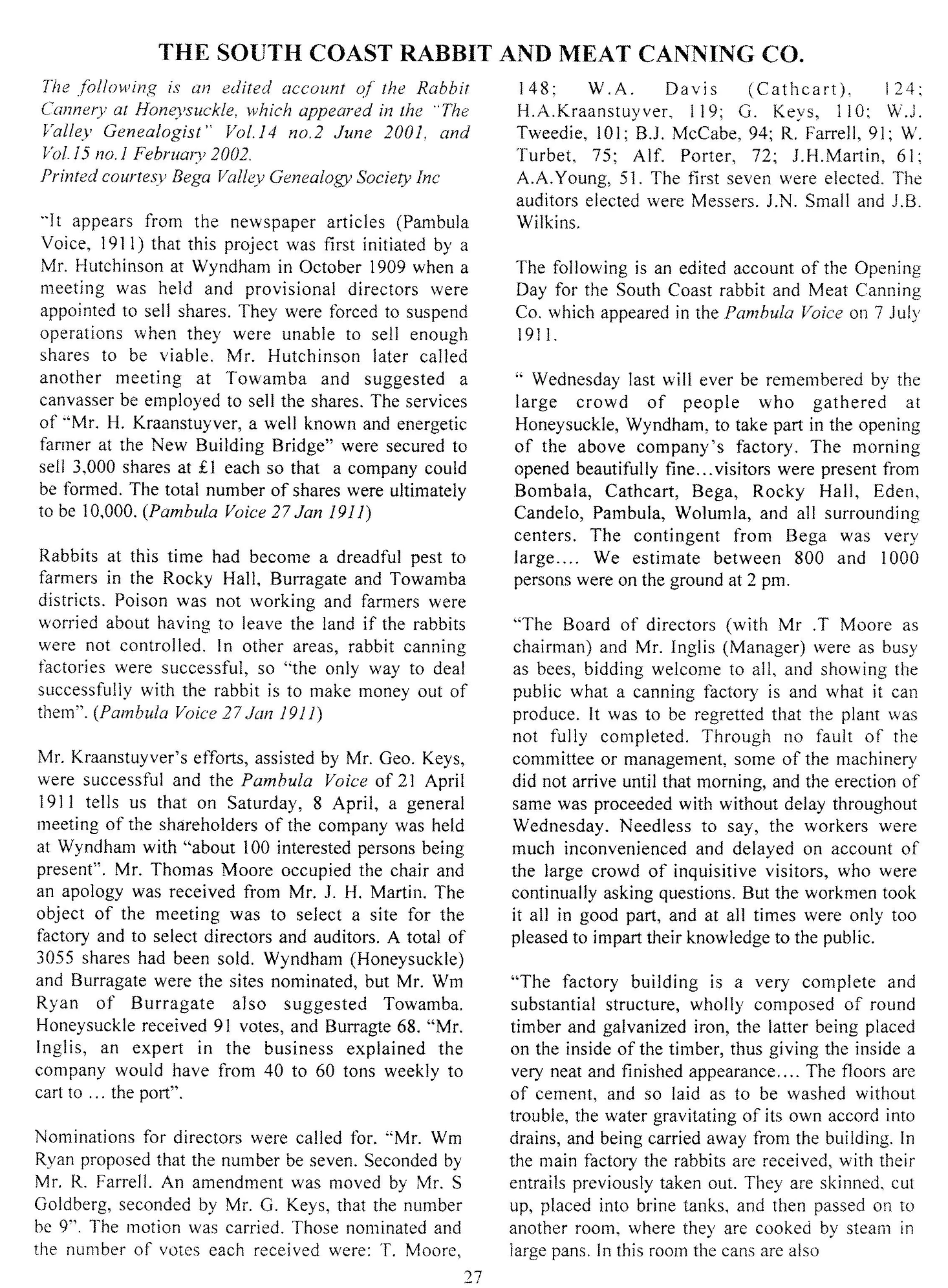
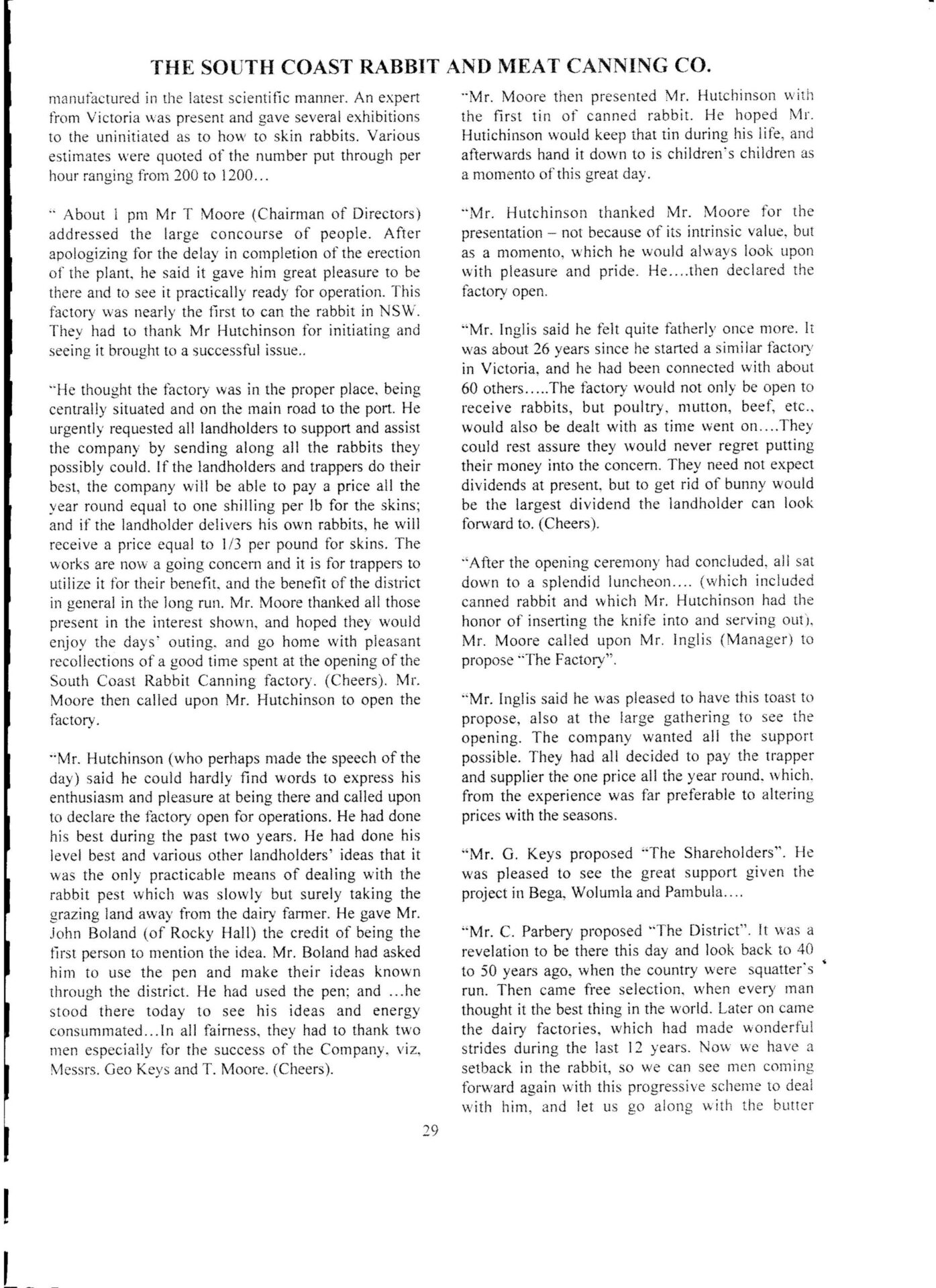
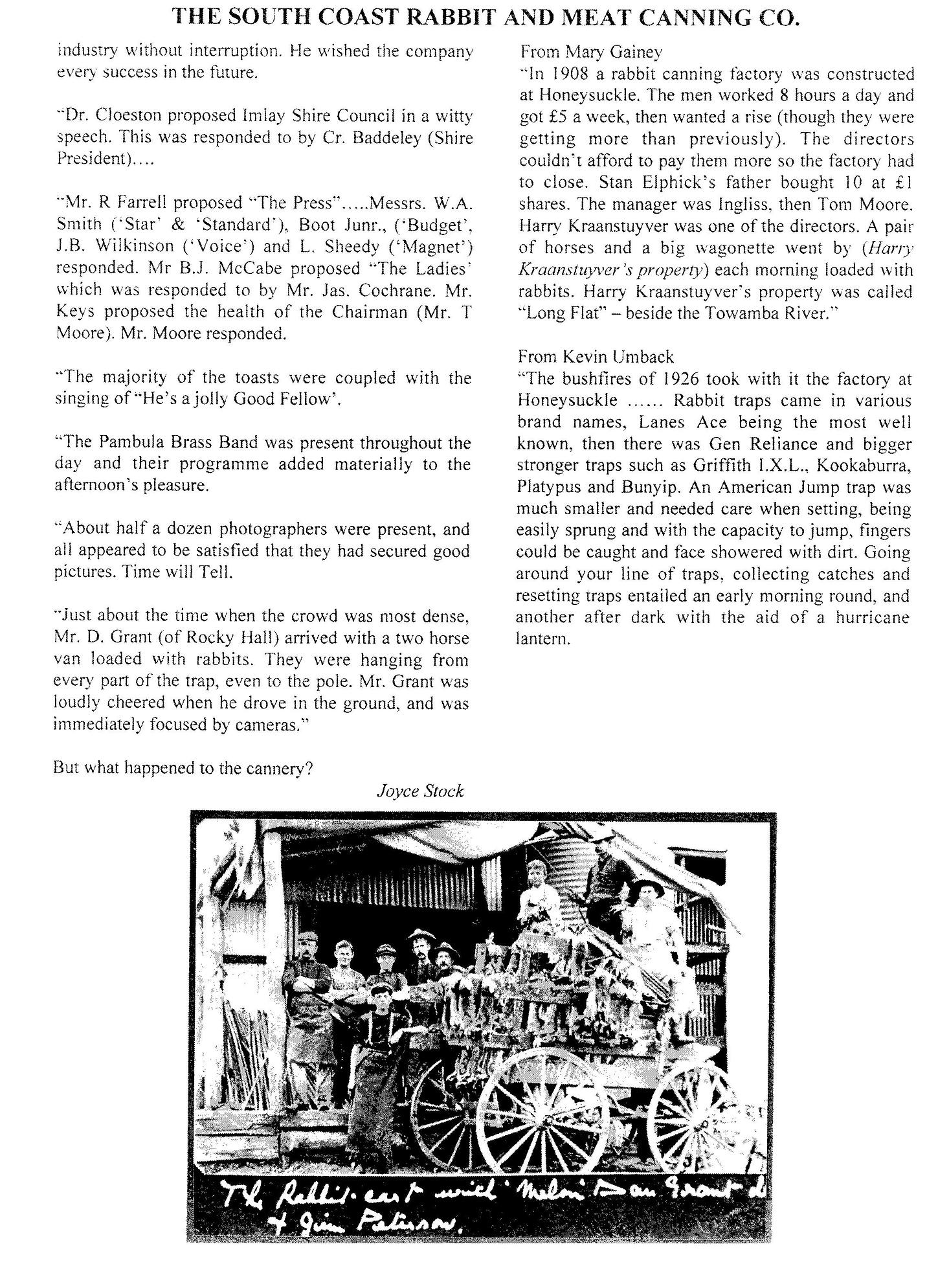
July 8, 1911 - 'The Bega Budget'
Rabbit Canning
WYNDHAM FACTORY OPENED.
On Wednesday last the much discussed canning factory was opened at Honeysuckle, just outside Wyndham. The day was beautifully fine, and hundreds of people came from all parts of the district for the opening ceremony.
The reason the factory is out of the town is because it is more convenient for trappers to bring in their rabbits from southern parts. The situation is an ideal one right beside a permanent supply of water, and just across the creek from the building is a large ferny hill which one would expect to see 'alive with rabbits.' The walls and sides of the factory are of galvanised iron, and the presence of a plentiful supply of substantial round timber greatly minimised the cost of construction.
The rabbits, which, of course, are cleaned by trappers, are received at a convenient platform by an expert, who carefully looks over the bunnies and rejects any doubtful ones. The ears and feet are chopped off and bagged for shipment to Melbourne where they are converted into glue.
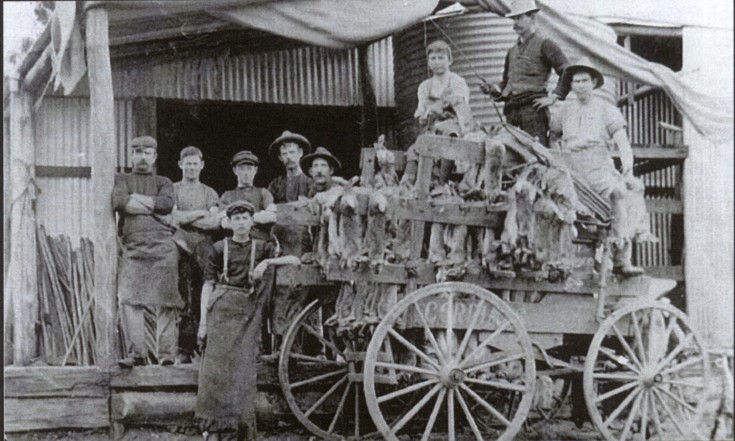
The skinner, who had a reputation of being able to do 400 an hour, then gets to work. Many ridiculed the idea of such a record, but once he started it was soon seen that it could easily be accomplished. He first parts the skin a little from the flesh in about the centre of the rabbit, hangs the carcase by the middle on a hook, and gives the skin one pull and the rabbit is ready to be cut up.
The same man is an expert in this department also, but can do about twice as many animals in the time. Five hits of the chopper is all that is required, and bunny falls in pieces into a huge tub of brine. The flesh is treated to two or three courses of brine of various strengths, and is really pickled before being put into tins. The article is tinned before being cooked, only a pin-hole being left in the tin.
This is soldered while the contents are hot, and the cooling process causes the vacuum so well known to people in the trade. With the addition of an attractive label the article is ready for market. All the tins are manufactured on the premises, and some surprisingly simple labor and time saving machinery is in use.
The tin is cut to size by a guillotine, and is then turned and made the shape of a tin, so that every tin will be exactly the same size. A tinsmith gets the tin round an iron cylinder and the edges are easily soldered. The bottoms fit exactly, and are soldered by being turned round in the solder so that just the edge is touched.
But it is the machine that cuts the lids that is a surprise packet for the average onlooker. With it one man can cut 1500 complete lids an hour with the edges turned. It is worked by a 3-h-p. engine, and must have enormous power to do the work it does.
Situated a few yards from the factory is a shed in which boys are engaged in putting the skins over wires to be dried, and the place contains hundreds in the drying process.
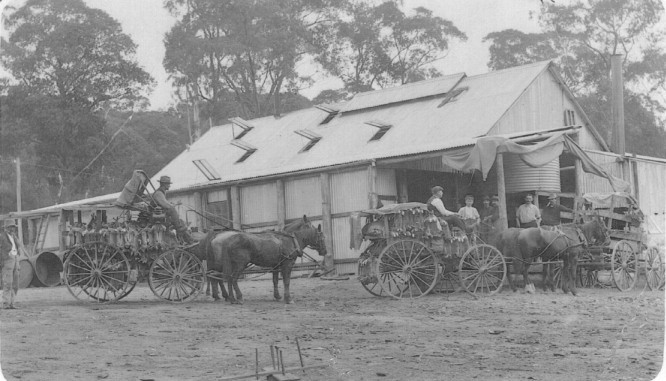
Through the boat not calling and the machinery being thus delayed, the factory was not quite in full working order, but the men worked all the previous night and up to one o'clock that morning in order that the public might see how the rabbits are treated.
A number of tins from the first batch were opened and placed on the dinner table. Everyone was anxious to taste it, and asked for 'just a little please,' but in many cases the order was repeated minus the 'little please.' There is not the slightest doubt that the article has a very presentable appearance and is extremely palatable. In fact, one man re marked that he had tasted stewed rabbit, curried rabbit, baked rabbit, and boiled rabbit, but they were all put in the shade by canned Wyndham rabbit. It is far superior to much of the preserved beef sold in this district.
Some poultry and beef were also in the pickling stage, but so far none has been turned out ready for market. In about a fortnight's time the first shipment of rabbit will be dispatched to an English firm, who, it is thought, will take the whole output.
On the day of the opening a lot of rabbits were brought in and one cart-load from Rocky Hall way was said to contain 750 pairs. Of course there are very few professional trappers in the district yet, and most of the bunnies are caught by amateurs. One young fellow with 60 traps has averaged 10s 6d a night since the factory opened. The price of 5d per pair is a very good one when it is considered that that price will rule the whole year round.
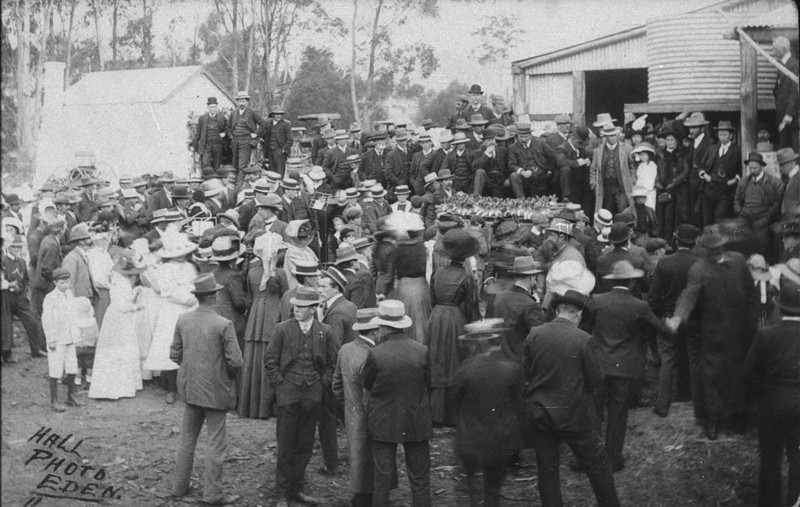
The Pambula band was on the ground and enlivened the proceedings by their selections. Altogether a most enjoyable time was spent by the visitors, and if the factory is only half as successful as the opening ceremony, then a new and flourishing industry has been established in the district which will benefit the farmer and business man alike. A large crowd then assembled at the rear of the building, where the official opening ceremony took place.
Mr. Thos. Moore, chairman of the directors, mounted a large copper beside the boiler and addressed the gathering. He said he regretted there was not a more capable speaker in his place on such an important occasion. He had to apologise to the visitors for the state the factory was in, but it was no fault of the directors. The weather was against them, and the boat took their machinery back to Sydney, thus delaying them at least a week. Although the place did not look much, it could not be put up without difficulty, and every day brought its own trouble.
This was pretty well the first rabbit canning company in N.S.W. There was no doubt that Mr. Hutchinson did more than any of them in bringing the factory into existence, and he was the backbone of what the people saw that day.
It was 18 months ago since the movement was started, when times were bad. The directors thought they would canvass for shares themselves, but only one man did any good. They therefore held a meeting and decided to abandon the project. There was no man more indignant at this than Mr. Hutchinson, who said the factory meant everything to the district. That gentleman kept on writing and enquiring, and collecting whatever information he could.
Then the Pambula Dairy Co. thought of dealing with frozen rabbits, but the idea did not materialise. Then Mr. Hutchinson and Mr. G. Keys called a meeting at Towamba, and he (the speaker) was put on the Board of Directors. There were only a few more meetings before the prospectus was issued and a canvasser put on. Then Mr. Ingles gave them all the possible information about canning; in fact, their case would have been hopeless only for him, for he told them everything.
Mr. Keys, at his own expense, took Mr. Ineles all over the district, and for this the community was very thankful. The speaker wishes to mention the capable canvasser, Mr. Kraanstuyver. It was hard for a man to make the public believe that canning was going to be what it was. As soon as 3000 shares were taken, a site for the factory was selected, and he believed it was in the right place. He trusted the landholders and trappers would work amicably together. If they were not going to support them, what was the use of them building.
The trappers had an industry for themselves, and if they wished to utilise it they would be paid a fair price for rabbits the whole year round. The speaker concluded a fitting address by thanking the employees for working day and night in order to allow the public to see the factory in working order. Mr. N. Hutchinson could scarcely find words to express his deep appreciation for the honor of formally opening the factory.
The idea of canning rabbits arose out of a casual conversation, between Mr. L. Diversi and. Mr. Jno. Bo land two years ago, and the latter suggested that they might find someone who could wield a pen to take the matter up. The first letter the speaker wrote was to a Wyndhamite, Mr. Goldberg, and that person took the trouble to interview a number of farmers who all fell in with the movement. Since then he wrote a lot of letters, and he had to thank the press for publishing them. They had met all kinds of opposition, but he could not understand a single farmer standing aloof from the movement, and using his influence against it.
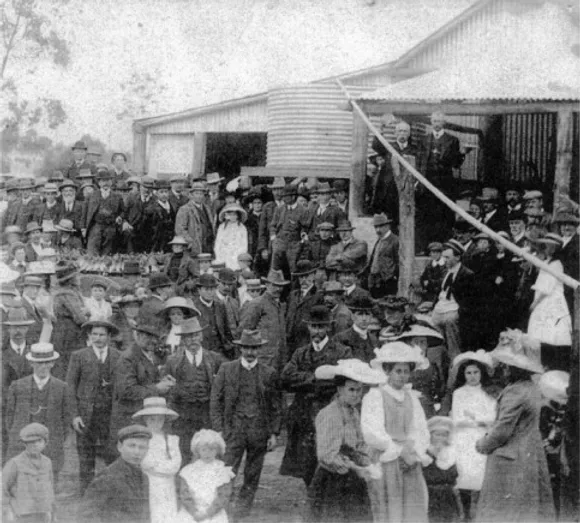
In reply to a letter, the Agent-General in London stated that skins were sold at 3s, 7s a lb., and some of these were bought in their own district for 8d. They would send their skins direct to London, and thus save all the middleman's expenses. They wanted the money distributed in this district. When he found out what price they could get for canned rabbit, he knew they were on solid ground, and for every rabbit caught he estimated that sixpence would be brought into the district. This meant a very consider able sum when it is remembered that thousands would be caught every week.
He had forgotten a lot he had to say, but there was one thing he would like to emphasise. He heard that some of the landholders meant to charge trappers a royalty. If such were the case it would be a shame, and he hoped the farmers would not take up such a selfish attitude. He thought that if any did they would not only go down to their graves unhonored, but with rabbits tied to their toes. Two men who had been closely associated with the speaker, and who had stood out prominently all through, were Mr. Keys and Mr. Moore, and without these two they would never have opened the factory.
At this stage Mr. Moore handed Mr. Hutchinson the first tin of rabbit turned out at the factory. Mr. Hutchinson was very thankful for the present, and would keep it and hand it down to posterity. He hoped it was only the fore runner of great things for the dist rict. Mr. Hutchinson then broke a bottle of wine over the boiler of the South Coast Canning Company. Mr. W. A. Kneen then called for three cheers for the Company which were lustily given.
Mr. Ingles, the manager stood in the centre of a cart-load of rabbits to make a speech. He said it was 26 years ago since he opened a canning factory in Victoria, and had since been associated with six other factories. That day he had much pleasure in opening another factory. When he first saw the possibilities of the district he did all he could to help the canning movement, and hoped it would develop into a much larger concern, and that beef, mutton, poultry, and other articles would be treated.
It would be an object lesson for the whole of the neighboring districts. There were many trials and difficulties, but they had all been mastered. The people must help the Company. For the sake of the farmer he would like to see the rabbits disappear, but the factory would not close up for they would deal with other kinds of meats. One English firm alone would take all the rabbits they could put in tins, and would make liberal advances.
Many were surprised at the small cost of the factory, and that nearly everything was paid for. He had to thank the people and directors and also Mr. Hutchinson for many kindnesses and considerations. It would have been wrong if someone else but the latter had opened the factory. He hoped the concern would be a dividend paying one, and that it would effectively cope with the rabbits and be the means of circulating money through the district.
The guests then sat down to an excellent luncheon - in fact, it was as good as many banquets - which was provided by the Wyndham ladies. After the inner man had had his requirements fully attended to, a toast list was quickly gone through. Mr. Ingles proposed 'The Factory,' and said there was a general feeling that the Co. should go ahead. He hoped there would be no friction between the landholder and trapper. They would pay a fair price all the year round for rabbits.
The whole community should join in helping the Company, and then everything would go with a vim. Mr. G. Keys proposed 'The Shareholders,' He said he was asked to do a little canvassing, and was successful at Pambula, Wolumla, Candelo, and especially Bega. He hardly met with a refusal. It would be surprising to many to know that the business people supported the movement better than the farmers.
Mr. C. Parbery proposed 'The District,' and expressed pleasure at being present. A great change had taken place in the district during the past 40 years. It was then practically a squatter's run. The place had since been closely settled, and butter and cheese factories had sprung up in various parts. Then the rabbit came and things looked gloomy, but now they had a way of coping with them. He was glad Bega had assisted the establishment of the factory. If it was a success no doubt others would be started elsewhere. The people of Wyndham deserved a lot of credit for their enterprise, and he would be pleased to see it turn out a huge success.
Dr. Clouston proposed 'The Imlay Shire Council.' He said that some time ago he got bogged and that bog was named after him, and ever since he had been asked to propose this toast wherever he went. Some day he would tell the Councillors what he thought of them. He was pleased to see such a large crowd present, and it showed the people took a great interest in their factory.
Cr. Baddeley responded, and said that at one time when they had about eighteen feet of rain in six hours, Dr. Clouston tried to drive his motor through a bad bog and got stuck, and the 'place had been immortalised as Clouston's Bog.' The place had been fixed up since and there would be no more bogs. He would specially mention Mr. Keys in connection with the canning factory, for, if anything, he was an enthusiast, and if he took a thing up he put his heart and soul into it. He hoped the industry would be of great commercial value and also be the means of reducing the rabbits.
Mr. R. Farrell proposed 'The Press, and said that in the establishment of the factory the district papers gave great assistance. Some went to the trouble to write leading articles, while they all had something to say. The toast was responded to by Messrs. W. A. Smith (on behalf of the 'Star' and 'Standard'), L. Sheehy ('Magnet'), J. Wilkins ('Voice'), and E. Boot (Budget). Mr. J. McCabe proposed 'The Ladies,' and said that if anyone went hungry that day they de served to do so.
Mr. Jas. Cochrane responded on behalf of the ladies, and thought they deserved great credit for the excellent spread they had provided for the guests. Mr. Parbery proposed the health of 'The Chairman,' and Mr. Moore in responding said the result of the opening was a great pleasure to him. What he had done in the past was now nothing to him, for he felt quite satisfied at the way everything had passed off.
The South Coast Rabbit and Meat Canning Company Ltd Rabbit cannery was located at Honeysuckle, on land that is now occupied by the Mt Darragh Rd and Burragte Rd intersection and the enterprise was wound up in 1915.
